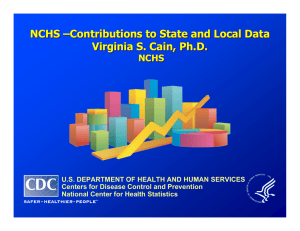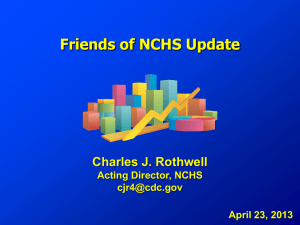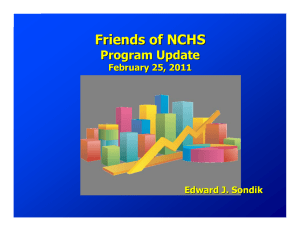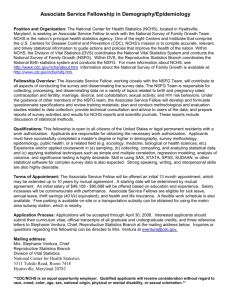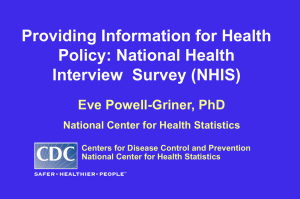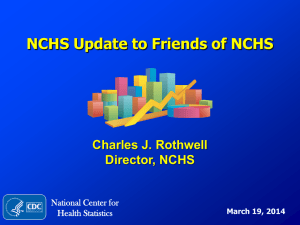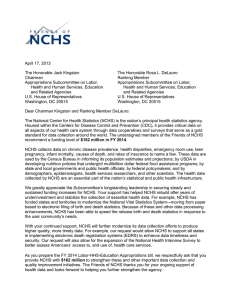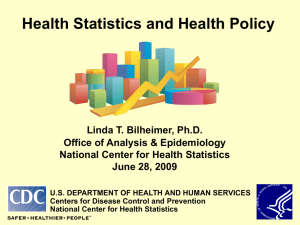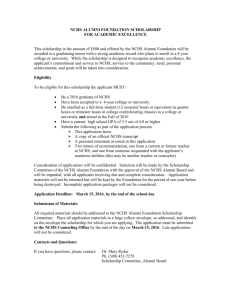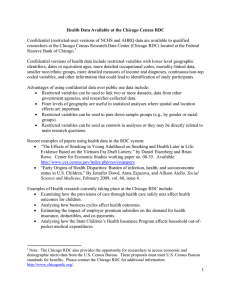NCHS Director’s Update to the Friends of NCHS Charles J. Rothwell Director, NCHS
advertisement
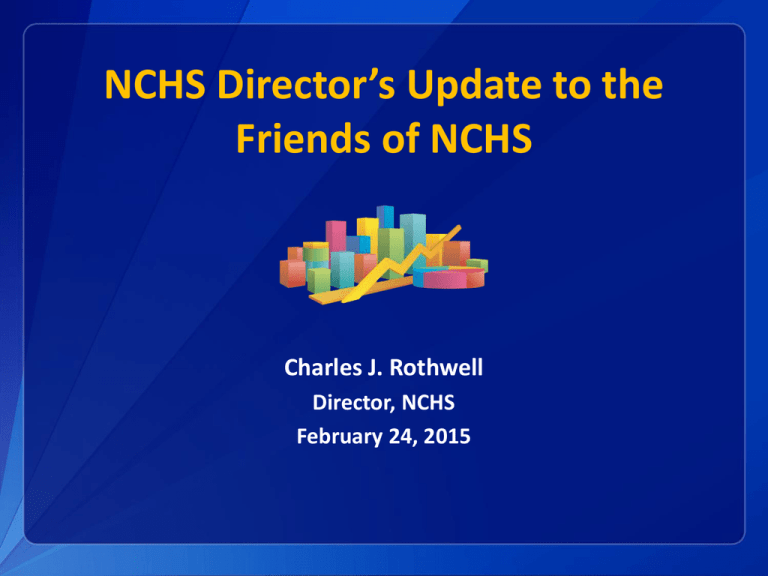
NCHS Director’s Update to the Friends of NCHS Charles J. Rothwell Director, NCHS February 24, 2015 ADMINISTRATIVE AND BUDGET UPDATES NCHS Staff Updates Nat Schenker appointed as NCHS Deputy Director, starting in February. Susan Queen announced as the new Associate Director for the Office of Planning, Budget, and Legislation—anticipated arrival in March. Jane Gentleman, Director of Division of Health Interview Statistics, retired in October 2014. • Marcie Cynamon is Acting Director of DHIS. FY 2015 Budget FY 2015 Health Statistics Appropriation: $155,397,000 in Budget Authority—level with FY 2014 and consistent with the FY 2015 request. • Includes funding for administrative and business services through the CDC Working Capital Fund (planning for about $17 million). • Shift to Budget Authority means we are subject to taps for which we were exempt while all PHS Evaluation Funds (about $3 million). No funds received from the Prevention and Public Health Fund (requested about $26 million) means sample increases for the National Health Interview Survey (NHIS) and National Ambulatory Medical Care Survey (NAMCS) and additional NHIS content would have discontinued in 2016. • CDC is providing one-time funds to continue some of the survey enhancements. FY 2016 Budget Request Requests $160,397,000 for health statistics—a $5,000,000 increase over FY 2015 enacted. • $5 million increase to expand electronic death reporting to provide faster, better quality data on deaths of public health importance, including prescription drug overdose deaths. • Includes funds for administrative and business services as part of the CDC Working Capital Fund—for comparison, planning for about $17 million in FY 2015. With this budget, NCHS would maintain ongoing health and health care surveys and purchase vital registration data. Other activities include: • Launch a new, more efficient National Health Interview Survey sample. • Investigate ways to incorporate administrative data and electronic health record information into health care provider surveys. FY 2016 Budget Request: Prevention and Public Health Fund Requests $12,000,000 from the Prevention and Public Health Fund for survey enhancements to better monitor changes in health care. • From FY 2010–FY 2013, the Prevention Fund supported additional content on the NHIS to measure ACA-relevant outcomes and sample increases for the NHIS and NAMCS. • Funds were requested but not received in FY 2014 and FY 2015. CDC recognized the advantages of these enhancements in providing data for monitoring changes in health and health care and provided funds in FY 2014 and FY 2015 to support some of the enhancements for the 2015 and 2016 surveys. RECENT ACCOMPLISHMENTS Provided Timely Access to Data to Monitor the Affordable Care Act • January – June 2014 National Health Interview Survey (NHIS) health insurance data released in December showed: The proportion with exchange coverage increased from 1.4% (3.7 million) in the first quarter of 2014 (January–March) to 2.4% (6.3 million) in the second quarter of 2014 (April–June). • Release of 2014 NHIS data anticipated in June 2015 – expected to include health insurance estimates for 50 states and DC thanks to the increased sample size. Improved Timeliness for Vital Statistics Following Investments to Improve Reporting • Births Preliminary 2013 birth data released in May 2014 – earliest ever. All states now have or are in the process of completing a webbased Electronic Birth Registration System using the 2003 Revisions of the U.S. Standard Certificate of Live Birth. • Mortality In 2014, we released final mortality data for 2011, 2012 and 2013 data years—a significant staffing accomplishment. • 2013 mortality data release was the first ever release within 12 months of the end of the calendar year in which data were collected. • Updated the National Death Index, thereby facilitating the work of health researchers seeking this information. While we have seen improvements, work remains to be done to improve mortality reporting. • 41 states have EDRS software as of Nov. 2014 - however, this does not mean that coverage is statewide and that all physicians participate. Since 2013, we have funded 9 states to improve their systems and/or processes in order to deliver at least 80% of their death records within 10 or less days after the date of the event. 100 Proportion of U.S. Mortality Records Received Within 10 Days of the Date of the Event by Year Years Target 80 Percent • 60 40 20 31 10.6 14 17.6 2011 2012 2013 0 2014 Testing Use of the National Vital Statistics System for Surveillance • For the first time, the CDC FluView report included a companion summary of flu mortality based on vital statistics data. http://www.cdc.gov/flu/weekly/ http://www.cdc.gov/flu/weekly/nchs.htm. Improving the Mortality Data Infrastructure for Patient-Centered Outcomes Research • Received $6.5 million from the Office of the Assistant Secretary for Planning and Evaluation for projects including: Work with up to 22 states on transmitting at least 80% of mortality records to NCHS within 10 or less days from the date of event. Pilot in one state the electronic exchange of relevant death record information between electronic medical records and EDRSs using the draft national HL7 exchange standards for mortality records. Pilot the linkage of the National Hospital Care Survey inpatient and emergency department data with the National Death Index data to measure within and post-hospital mortality. Innovations in Data Collections: 24-hour urine Gallons of Urine Collected through NHANES Gallons 800 700 600 500 400 300 200 100 0 2009 2010 2011 2012 Year 2013 2014 Innovations in Measure and Data Development • Advances in data linkage First time linkage between NCHS surveys and data from the Department of Housing and Urban Development. New knowledge about approaches for improving linkage. • • Conducting research on combining information from multiple data sources. In particular, investigating how data from other data systems and web surveys, as well as “big data,” might be used to enhance estimation based on NCHS data systems. New survey items for international comparison of functional status and disability. Moving to Electronic Data Collections • • Laid the groundwork to move from manual data collection to data collection using EHRs for National Health Care Surveys. Developed an Health Level International (HL7) Implementation Guide (IG) for the National Health Care Surveys. http://www.hl7.org/implement/standards/product_brief.cfm?product_id=385 Improved Data Access Need to quickly find the latest health statistics? There’s an app for that. • New NCHS FastStats app makes accessing health statistics faster and easier than ever. NCHS Data Online Query System (DOQS) launched with emergency department data from the National Hospital Ambulatory Medical Care Survey. • Users can generate and store analyses and create tables, charts, and graphs using NCHS public-use data. http://www.cdc.gov/nchs/doqs/index.htm 2015–2016 PRIORITIES 2015–2016 Priorities • • • • Maintain strength of 2016 NHIS and NAMCS in order to provide state estimates and information for evaluating the changing health care landscape. Continue to provide timely access to data to monitor changes in the provision of health care. Even faster vital statistics reporting. Continue the expansion of uses for vital statistics for CDC surveillance activities. Continue working with EHR vendors to develop an interface that enables hospitals to forward their inpatient and outpatient data for the National Health Care Surveys. 2015–2016 Priorities • • • • Continue to investigate data visualization methods. Address the growing number of health measures at state, regional and national level that must be analyzed, harmonized, updated, housed and disseminated. Recruit and retain staff for key positions, and for individuals with appropriate technical and substantive skills. Bring together data users at the National Conference on Health Statistics. THANK YOU!!!
